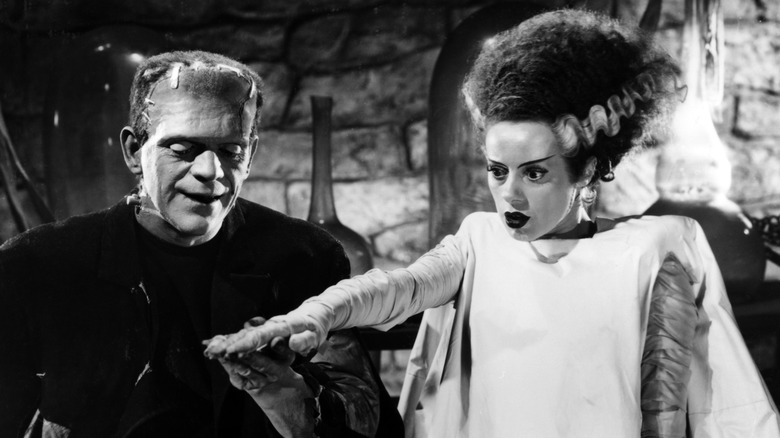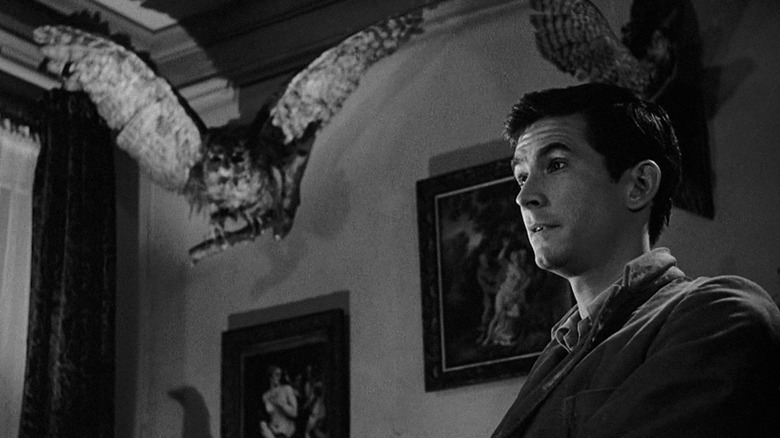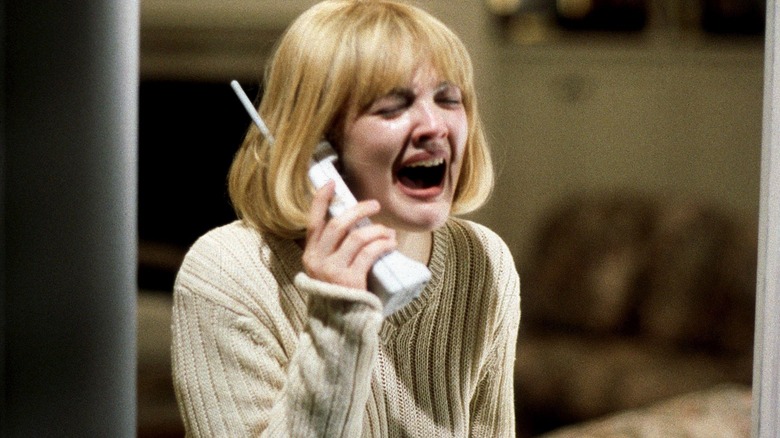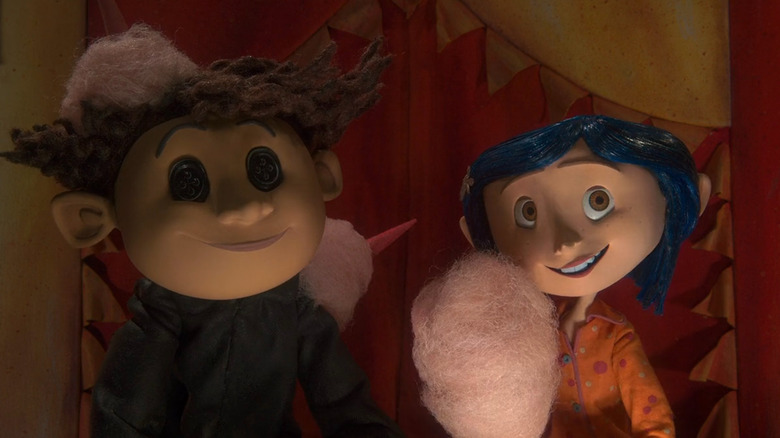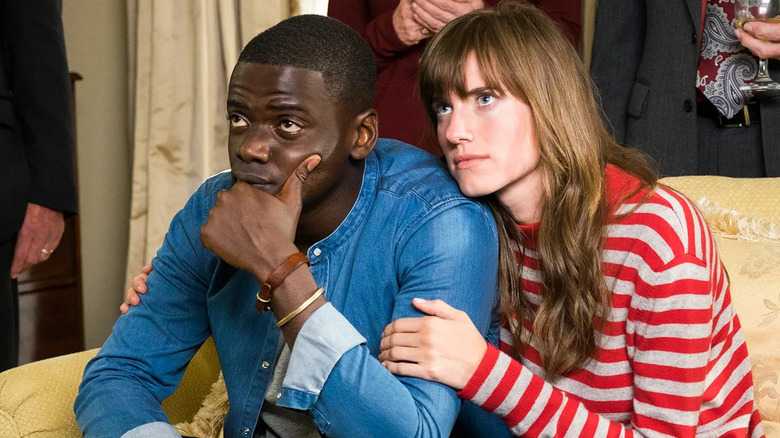The 5 Best Horror Movies For Scaredy Cats
Horror fans all know the pain. You have that one friend whom you fail to have a full emotional connection with simply because they won't indulge in your endless rewatches of '80s slasher flicks and Ari Aster's filmography.
But it's a simple fact — horror movies are scary, as they should be. The genre presents audiences with a heightened sense of fear that not only entertains but can help viewers face the scary situations occurring in their own lives. And while plenty of movie fans can't get enough of scream queens, haunted locations, and blood-splattered killers hunting down leisure-loving teens, it can be too much for those who'd rather opt for a smoother cinematic experience.
Thankfully, horror doesn't come in one shade of paint. With as diverse a genre as horror can be, viewers have endless paths to explore to settle on what works for them. For those looking for a way to ease into the genre — and others looking to get their friends into it — there's no shortage of lighter horror fare that will give you a good idea of this style of storytelling. The following list contains flicks that not only are great for the novice scary movie viewer but also act as a crash course in horror history. Turn the lights down, grab some popcorn, and let's dive right in.
Bride of Frankenstein
As cinema entered the sound age, horror movies also went through an evolution. At the forefront of this change was the Universal Horror lineup, which took place between 1931 and 1956. This era birthed countless screen icons, from Bela Lugosi's Count Dracula to Lon Chaney Jr.'s Wolfman to Claude Rains' Invisible Man. But the ringleader of this frightful bunch was the terrifying yet tender Frankenstein's Monster, played by Boris Karloff. And while 1931's "Frankenstein" was an undeniable game-changer, its 1935 sequel, "Bride of Frankenstein," is required viewing whether or not you're a horror junkie.
The Monster turns out not to have died following the events of "Frankenstein" and goes on another rampage across the countryside. Through the insistence of both the Monster and the nefarious Dr. Pretorius (Ernest Thesiger), Henry Frankenstein (Colin Clive) is tasked with creating a female companion for his notorious creation. The things that terrified audiences nearly 90 years ago likely won't have the same effect on most viewers nowadays, which can be said of most of Universal's monster library. Nevertheless, one glance at the German expressionist-inspired interior sets and foggy grave sites in these classics gives no doubt as to what category they belong in.
"Bride" represents the pinnacle of this Golden Age. The always-reliable James Whale directs the picture with grace, seamlessly weaving through moments of comedy, thrills, and genuine pathos with the greatest of ease. The film is less of a horror flick and more a character study of Frankenstein's Monster himself, whose failed efforts to find acceptance paint a tragic tale. Topped off by a fantastic cast and Franz Waxman's riveting musical score, "Bride of Frankenstein" makes for a stellar piece of cinema.
Psycho
The 1960s would be a game-changing time for the horror genre, as movies transitioned from the lavish, fantastical realms of the Universal Monsters to a new breed of frightful filmmaking that was more anchored in reality. While there are plenty of exceptional offerings from this era, such as "Night of the Living Dead," "Rosemary's Baby," and "Carnival of Souls," perhaps the most influential — and easiest to watch for non-horror aficionados — is Alfred Hitchcock's 1960 classic, "Psycho."
Based on the 1959 Robert Bloch novel of the same name, the film follows Phoenix secretary Marion Crane (Janet Leigh), who, while on the run with stolen money, finds herself at a motel owned by the unassuming Norman Bates (Anthony Perkins). After Crane goes missing, her close friends launch an investigation that unveils a shocking discovery about Bates. While many credit "Psycho" with setting the stage for the slasher subgenre, it's not as violent as one might assume. Far from, as not even the film's iconic shower stabbing scene ever sees the knife come in contact with flesh, rather implying the violence through clever editing and Bernard Herrmann's chilling musical score.
What "Psycho" lacks in graphic imagery it makes up for through its suspense-driven narrative. The iconic performances of Anthony Perkins and Janet Leigh complement Hitchcock's masterful direction and Joseph Stefano's rich screenplay, all contributing to an experience that delivers a never-ending sense of tension. Even if you think you know "Psycho" from its countless array of homages and parodies, it's more than worth seeking out the classic to see where it all stems from. And do everything in your power to steer clear of the 1998 remake. You'll thank us for that.
Scream
When it comes to slasher movies, a good few could have made this list. As the subgenre entered the mid-1980s and early 1990s, many slasher movie franchises were being played for laughs, with their masked villains quickly becoming quippy, fan-favorite anti-heroes. From "Texas Chainsaw Massacre 2" to "A Nightmare on Elm Street 4: The Dream Master" to "Bride of Chucky," there's no shortage of campy killer cult classics that would hardly scare most kids nowadays. But 1996's "Scream" not only poked fun at this trend but entered the scene with a level of freshness all its own that has yet to wane.
Following the sudden murder of a small-town high schooler (Drew Barrymore), a group of teens finds themselves at the mercy of a mysterious masked killer. "Scream" is certainly more gory than some of the other movies on this list, but it nevertheless makes for a good introduction to the slasher genre. Helmed by "A Nightmare on Elm Street" creator Wes Craven, the film both celebrates and mocks the many tropes of slasher flicks while also delivering on its own rich mythos and stellar suspense.
Its storytelling remains breezy while tightly weaving together characters, events, and plot points to subvert expectations and keep viewers guessing as to the outcomes of certain reveals. While some of them aren't the most surprising, the film is so fun and excellently paced from start to finish that you find yourself engrossed either way. If you're finally ready for some red in your horror viewing, few movies entertain quite like "Scream."
Coraline
Chances are, you've grown up with a good few nightmarish movie experiences as a child. Countless classic family films, such as "The Wizard of Oz," "Pinocchio" (both Disney's and Guillermo del Toro's versions), "The Dark Crystal," "Matilda," and "Spirited Away," are renowned for traumatizing generations of young moviegoers. But while most of these fall under the fantasy genre, there are far fewer options available when it comes to straight-up horror viewing for kids. But within this limited library, 2009's "Coraline" stands tall as a truly chilling venture for viewers of any age.
The stop-motion animated feature follows a young, blue-haired girl (voiced by Dakota Fanning) who discovers a hidden universe within her new home that, while seemingly superior to the reality she knows, hides an unsettling secret. Henry Selick, best known for his similarly sinister stop-motion directorial efforts, such as "The Nightmare Before Christmas," "James and the Giant Peach," and "Wendell and Wild," delivers a true feast for the eyes with "Coraline." The film's rich art direction and groundbreaking stop-motion visuals — the first of their kind to be shot in 3D and utilize 3D printing technology — lend to its haunting atmosphere.
Its plot and world-building are equally elaborate, playing out as a coming-of-age story that keeps viewers on the edge of their seats as more twisted secrets are unveiled. The less said the better about "Coraline" if you have yet to see it, other than that it's a must-see jewel of horror animation.
Get Out
Even if you're not into horror, it's more than likely that the filmography of Jordan Peele has come across your radar in recent years. Quite frankly, any entry from his ever-expanding filmography could have been included here, from his highly underrated 2019 horror film, "Us," to his 2022 chilling sci-fi epic, "Nope." But without a doubt, his 2017 directorial debut, "Get Out," remains his freshest work, having earned its rightful title as a modern genre classic.
The film follows Chris (Daniel Kaluuya), a Black man who tags along with his white girlfriend, Rose (Allison Williams), to stay with her parents for the weekend. Little does he know, a sinister plan is cooking with Chris' name all over it. Low on extreme violence while being high on entertainment value, "Get Out" makes for a perfect easing into the current age of horror cinema, with its oddball ideas melding seamlessly with the societal themes it tackles. Peele's known knack for comedy amplifies the quality of his horror work, making "Get Out" as much a satire about interracial relationships as it is a horrifying depiction of modern-day slavery.
The film's exquisite Oscar-winning screenplay holds it together, effortlessly balancing its many tonal shifts while both hiding and revealing information in endlessly creative ways. You can watch "Get Out" 1,000 times and still uncover new details, some so blatantly in your face that you'll be dumbfounded as to how you didn't notice them before. But that's simply the magic of this movie.

